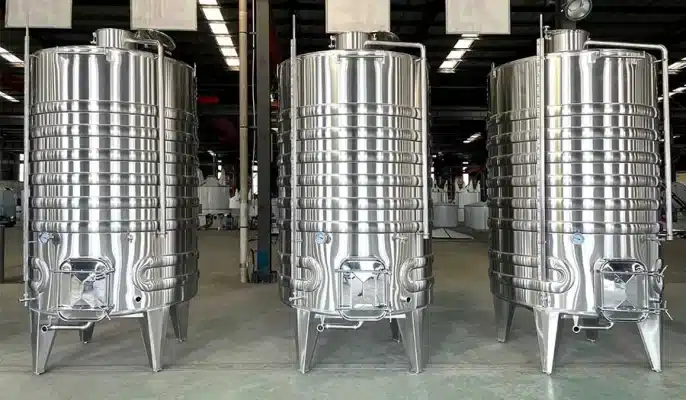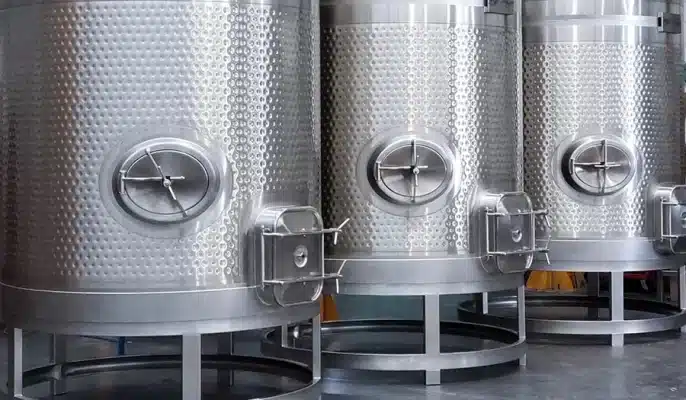La fermentación es un paso crucial en el proceso de elaboración del vino. No sólo determina la concentración de alcohol del vino, sino que también afecta directamente a su sabor y aroma. Elegir el recipiente de fermentación adecuado es un reto clave para los vinicultores. El material, la forma, el tamaño y la estanqueidad del recipiente de fermentación afectarán en cierta medida a la calidad final del vino. Este artículo explorará el mejor recipiente para fermentar el vino con el fin de ayudar a los lectores a tener una comprensión más completa de este complejo e interesante mundo de la elaboración del vino.
El proceso básico de fermentación del vino
Después de colocar las uvas en el tanque de fermentaciónse producirá la primera fermentación, común a todos los vinos. Durante este proceso de fermentación, el azúcar de la uva comienza a convertirse en etanol en un entorno con oxígeno y temperatura controlados. Esta fermentación se denomina "fermentación alcohólica". Durante el proceso de fermentación, no sólo se produce alcohol por la acción de la levadura, sino que también se produce dióxido de carbono y calor, dos elementos que es necesario controlar. El dióxido de carbono producido es una parte importante de la elaboración del vino espumoso.
En general, los vinos blancos y rosados con sabores frescos y afrutados son más adecuados para la fermentación a baja temperatura. Los vinos tintos con sabores más intensos y mayor contenido en taninos son más adecuados para la fermentación a alta temperatura. Esto se debe a que a temperaturas más altas se puede extraer más color y taninos, pero se perderán algunos sabores a fruta fresca.

¿Qué son los depósitos de vino?
Los depósitos para vino ayudan en el proceso de fermentación, garantizando el crecimiento adecuado de la levadura, controlando el oxígeno y permitiendo que el vino envejezca durante más tiempo. No todos los depósitos de fermentación son iguales. Algunos tanques de fermentación pueden hacer que el vino tenga un sabor más suave, pleno o afrutado. También se utilizan para diversos fines, como la clarificación y la eliminación de taninos, proteínas y otros sólidos. Los depósitos de vino se fabrican con distintos materiales. Los tres recipientes más populares son el acero inoxidable, el hormigón y el roble. Cada uno de ellos permite la entrada de una cantidad diferente de oxígeno en el vino.
Material del depósito de fermentación de vino
- Acero inoxidable: Muchos bodegueros prefieren los depósitos de acero inoxidable por su resistencia a la corrosión y su fácil limpieza. Tienen un buen rendimiento en el control de la temperatura, por lo que el proceso de fermentación puede llevarse a cabo en un rango de temperatura relativamente estable. Además, las propiedades neutras del acero inoxidable no afectan al sabor del vino, por lo que el cuerpo del vino puede mantenerse más puro.
- Barricas de roble: Las barricas de roble tienen una larga historia en la elaboración del vino. No sólo pueden almacenar vino, sino que también aportan un sabor a madera y una complejidad únicos al vino durante el proceso de fermentación. La estructura microporosa del roble permite que el vino tenga un cierto grado de contacto con el oxígeno, lo que es muy importante para algunos vinos que necesitan oxidación (como el vino tinto).
- Envases de vidrio: Las botellas especialmente grandes (como las de Gironda) y los fermentadores abiertos se utilizan gradualmente en algunas bodegas pequeñas. Como son populares porque no reaccionan con el vino, los recipientes de vidrio se utilizan generalmente para la elaboración de cerveza a pequeña escala y experimental.
- Envases de plástico alimentario: En algunos casos, los recipientes de plástico alimentario también se utilizan como contenedores de fermentación. Aunque en la mayoría de los casos los recipientes de plástico sustituyen a las barricas de acero inoxidable o de roble, su bajo precio y su poco peso permiten utilizarlos en algunas producciones a pequeña escala.
- Recipientes de materiales mixtos: Algunos bodegueros están empezando a experimentar con el uso de recipientes de materiales mixtos durante la fermentación, que pueden combinar las ventajas de distintos materiales. Por ejemplo, algunas barricas pueden tener tratamientos especiales en el interior para mejorar el contacto con el vino.
Tipos de acero inoxidable depósitos de fermentación de vino
Los tanques de fermentación de vino de acero inoxidable son equipos de uso común en la vinificación moderna y son ampliamente favorecidos por su resistencia a la corrosión, fácil limpieza y buen rendimiento de control de temperatura. Según las diferentes necesidades y funciones, los depósitos de fermentación de acero inoxidable pueden dividirse en los siguientes tipos:
- Depósitos de fermentación verticales: Los tanques de fermentación verticales son el tipo más común y son adecuados para bodegas comerciales a gran escala. Suelen tener una gran capacidad y son convenientes para la fermentación por lotes. El diseño vertical proporciona una buena separación por gravedad, lo que hace que la agitación del líquido fermentado y la precipitación de la levadura sean mejores.
- Cubas de fermentación horizontales: Los depósitos de fermentación horizontales son menos comunes y suelen utilizarse para tipos específicos de producción de vino. El diseño horizontal hace que el equipo ocupe menos espacio y es adecuado para bodegas con espacio limitado.
- Cubas de fermentación con control de temperatura: Los depósitos de fermentación a temperatura controlada están equipados con avanzados sistemas de control de la temperatura que pueden ajustar con precisión la temperatura durante el proceso de fermentación. Esto tiene un impacto importante en el sabor y la calidad del vino, permitiendo a los vinicultores optimizar según las necesidades de las diferentes levaduras.
- Tanques de fermentación con dispositivos de agitación: Este tipo de tanque de fermentación tiene un dispositivo de agitación incorporado que puede agitar dinámicamente el vino durante el proceso de fermentación, promover el contacto completo entre la levadura y el azúcar, mejorando así la eficiencia de la fermentación, y es especialmente adecuado para los procesos de elaboración de cerveza que requieren una fuerte agitación.
- Tanque de fermentación de separación Los tanques de fermentación de separación suelen estar equipados con dispositivos de separación, que son convenientes para la limpieza a tiempo de los sedimentos después de la fermentación, ayudando a mejorar la claridad y la calidad del líquido fermentado. Este tanque es especialmente adecuado para vinos que necesitan tratar los sedimentos a tiempo.
- Pequeño tanque de fermentación experimental: Este tanque de fermentación suele utilizarse para la elaboración de cerveza a pequeña escala o experimental. Tiene un volumen pequeño y es adecuado para principiantes o enólogos que están desarrollando nuevos vinos. Los tanques de fermentación pequeños ofrecen más espacio experimental para probar diferentes recetas y técnicas.

Cómo elegir un acero inoxidable tanque de fermentación de vino?
- Escala de producción: Elija el tanque adecuado según su escala de producción. Si se trata de una pequeña elaboración de cerveza familiar, puede elegir un tanque más pequeño; si se trata de una producción comercial, necesita un tanque de gran capacidad.
- Tamaño del lote: Tenga en cuenta el tamaño del lote de cada fermentación para poder elegir un depósito adecuado que evite los cambios frecuentes de depósito o el desperdicio de espacio.
- Material del depósito: El acero inoxidable de alta calidad (como el acero inoxidable 304 o 316) es resistente a la corrosión, a la oxidación y a las altas temperaturas, y es adecuado para el uso a largo plazo. La superficie interior lisa puede reducir el contacto entre el vino y la pared del tanque y evitar el crecimiento de bacterias.
- Sistema de control de la temperatura: Algunos tanques de fermentación de vino tinto están equipados con un sistema de temperatura constante que puede controlar con precisión la temperatura durante el proceso de fermentación, que es crucial para el sabor y la calidad del vino. Si no hay un sistema incorporado, asegúrese de que el depósito puede adaptarse al uso de un equipo externo de control de la temperatura.
- Presupuesto de costes: Elija la configuración funcional en función de las necesidades reales para garantizar que se cumplen las condiciones necesarias en el proceso de vinificación sin invertir en exceso en funciones innecesarias. Elija un tanque de fermentación rentable de acuerdo con su presupuesto. Aunque la inversión inicial en un tanque de fermentación de alta calidad es elevada, la durabilidad a largo plazo y los costes de mantenimiento pueden resultar más rentables.
- Marca y proveedor: La elección de una marca de renombre puede permitir obtener un mejor servicio y asistencia posventa. Los bodegueros que participan en evaluaciones de comentarios pueden ayudar a comprender el rendimiento real y la experiencia de uso de los equipos de fermentación de vino tinto.
PREGUNTAS FRECUENTES
¿Qué es un depósito de fermentación de vino?
Un depósito de fermentación de vino es un recipiente dedicado a la fermentación del vino, normalmente de acero inoxidable, vidrio o plástico apto para uso alimentario. Ayudan a la levadura a convertir el azúcar de la uva en alcohol y a producir dióxido de carbono.
¿Cuáles son las ventajas de los depósitos de fermentación de acero inoxidable?
Los depósitos de fermentación de acero inoxidable son resistentes a la corrosión y a las altas temperaturas, fáciles de limpiar y tienen una buena conductividad térmica y durabilidad. Al mismo tiempo, la superficie lisa del acero inoxidable puede reducir el crecimiento bacteriano y garantizar la pureza del vino.
¿Cómo debe elegirse el tamaño del depósito de fermentación?
El tamaño del tanque de fermentación debe seleccionarse en función de la escala de producción y los requisitos del lote. Por ejemplo, los cerveceros caseros pueden elegir tanques más pequeños (como de 20 litros), mientras que las bodegas comerciales suelen necesitar tanques de gran capacidad (como de cientos de litros).
¿Qué importancia tiene el sistema de control de la temperatura en la fermentación?
El sistema de control de la temperatura es crucial para el proceso de fermentación porque las distintas levaduras tienen diferentes sensibilidades a la temperatura. Controlar la temperatura puede afectar a la velocidad de fermentación, el aroma y el sabor del vino, y evitar la inactivación de las levaduras o los malos sabores causados por las altas temperaturas.
¿Cómo limpiar y mantener el tanque de fermentación?
Es muy importante limpiar el depósito de fermentación con regularidad. Puede utilizar agua tibia y detergente apto para alimentos para limpiarlo, o puede utilizar un oxidante o vapor para limpiarlo y eliminar los restos de levadura y azúcar. Asegúrese de que el depósito esté completamente seco después de cada uso.
¿Qué tipos de cubas de fermentación existen?
Los tipos más comunes son los depósitos de fermentación vertical, los depósitos de fermentación horizontal, los depósitos con dispositivos de agitación, los depósitos de fermentación a alta temperatura, etc. Los distintos tipos de depósitos se adaptan a diferentes necesidades de producción y estilos de vino.




